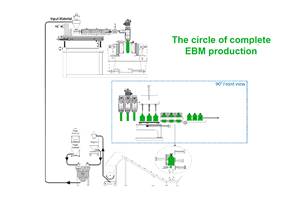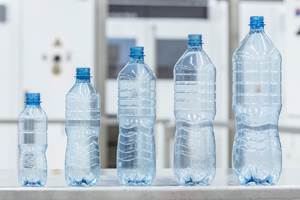Making a Part for the First Time? Here’s How to Get Going
First time parison programming for a new part can be lengthy and tedious. Here's some advice on making the process a bit easier
The accumulator head is the most important component of an industrial blow molding machine. Likewise, forming a parison profiled
to the proper wall thickness for a given part is mandatory to get consistent parts that meet specifications.
First-time parison programming for a new part can be a very lengthy and difficult process. It all depends on what type of part is being made: Is it round or rectangular with a small height? What about the blow ratio of the parison into the mold areas? Those are just two of the issues that need to be addressed. Then relate those factors to the original wall thickness of the parison at various segments along its length. Blow molding machine and head performance and optimal settings are usually different from machine to machine. Every machine has its own personality, and you need to learn these differences. The key issues are how to set up the parison length and profile points to make an acceptable part.
First, estimate the length of parison required. Measure the mold length and the distance from face of the tooling mandrel to the top of the mold. Determine the additional parison length below the bottom of the mold required for pre-pinch, blow-pin stand, and parison spreader (depending on what is required to make the part). Then determine the layflat of the parison to size head tooling.
Next, determine the actual length of the parison. Experience is especially important when doing this for a new mold and part design. Refer to any similar parts previously produced to assist in factoring the proper shot size. It is better to be longer on the parison than too short. If you have a short shot you’ll wind up with a glob of plastic lying in the bottom of the mold or floor. Making an actual part will enable you to make critical changes on the next shots.
This is not yet the time to configure any parison profile steps. Instead, check the finished weight of the part and measure its wall thickness in critical areas. Review those results and consider areas that require major profile changes.
Make sure the parison drops straight on a consistent basis.
Now consider how much space is needed between the bottom of the head tooling face and the top of the mold. Round parts can allow the tooling face to be closer to the top of the mold. This minimizes the amount of top and bottom flash. But flat panels and molds with small shut height (thickness) must be farther away from head tooling due to parison arching angles back to the head tooling. This might require using a pre-pinch unit to “balloon up” the parison diameter. (It’s like a blown up bag.)
The parison must be long enough to allow pinch bars to seal the parison bottom and clear the mold. The job might also require parison spreader pins (or blow-pin movement for offset necks). These features could require either longer parisons or cutouts in the molds for the spreader pins. Once you pre-pinch the parison, you might need to slow closing of the press to allow the inflated parison to fit into the deep-draw areas of the mold.
If you are running a dual-head machine with two molds of the same or different products, run just one head first to develop the necessary processing points. This will make it quicker to make good parts. Once you can make a series of good parts, you can transfer the details and setpoints to the second head if it is the same part on both heads. Most likely, minor changes will be required for the second head, which can be programmed accordingly.
To estimate the weight of the parison (best guess), determine how much flash might be required on the top, bottom, and sides of the parts. Once you have repeated the parison weight and length for three or four shots, you can start profile programming of the thin and thick parts of the parison and part. It is a time-consuming chore to measure wall thickness in various areas of the part and parison. It will be a great help if the parison can be manually purged out at the proper speed and profile steps to determine the set-up for automatic operation.
Some parison programming units allow you to place a spike (a thick parison numbered point) in a given area that might be too thick or thin. This will enable you to quickly find the correct location (profile numbered point) for the change.
Some systems allow you to accurately trace the actual profile path after the parison is dropped, as compared with the setup profile. This will improve the speed at which you can achieve the correct area thicknesses. It will also indicate places that you are asking the machine to accomplish too abrupt a change in thickness and the mechanical parts cannot react fast enough. That will produce a wide variation in wall thickness in those spots.
Use as many “master” setpoints as needed, but don’t overdo it. There are systems available that allow smoothing of the master points by either holding the original master points’ position or allowing them to “travel” with the smoothing feature. Make only one programming change at a time and stick with it until you are sure it can or cannot accomplish the desired results. Remember the drawdown effect from gravity on the top section of the parison. In most cases, this area must be thickened.
How fast should the parison be pushed out? This certainly will affect parison swell and the total amount of flash. Fast parison drop in most cases will increase the layflat. Trying to vary the parison drop speed is very difficult to control in relation to exact positions along the parison.
In many cases, the mold might stay in the machine only a few days. This is not enough time to set up the proper parison profile. You could make many reject parts trying to get the acceptable part dimensions needed in such a short time in the machine. The saving grace, in many cases, is to ship parts that are on the heavy side to ensure they won’t be rejected by the customer. The negative consequence will be additional costs for the heavier parts, which can eat up your profit.
You may even need to change the head tooling size in order to make an acceptable part. If so, you will probably have to do the above functions all over again with new tooling.
Related Content
NPE2024 Wrap-Up: Sustainability Dominates Show Floor News
Across all process types, sustainability was a big theme at NPE2024. But there was plenty to see in automation and artificial intelligence as well.
Read MoreGet Color Changes Right In Extrusion Blow Molding
Follow these best practices to minimize loss of time, material and labor during color changes in molding containers from bottles to jerrycans. The authors explore what this means for each step of the process, from raw-material infeed to handling and reprocessing tails and trim.
Read MoreFirst Water Bottles With Ultrathin Glass Coating
Long used for sensitive juices and carbonated soft drinks, KHS Freshsafe PET Plasmax vapor-deposited glass coating is now providing freshness and flavor protection for PET mineral water bottles.
Read MoreFoam-Core Multilayer Blow Molding: How It’s Done
Learn here how to take advantage of new lightweighting and recycle utilization opportunities in consumer packaging, thanks to a collaboration of leaders in microcellular foaming and multilayer head design.
Read MoreRead Next
See Recyclers Close the Loop on Trade Show Production Scrap at NPE2024
A collaboration between show organizer PLASTICS, recycler CPR and size reduction experts WEIMA and Conair recovered and recycled all production scrap at NPE2024.
Read MoreBeyond Prototypes: 8 Ways the Plastics Industry Is Using 3D Printing
Plastics processors are finding applications for 3D printing around the plant and across the supply chain. Here are 8 examples to look for at NPE2024.
Read More
























